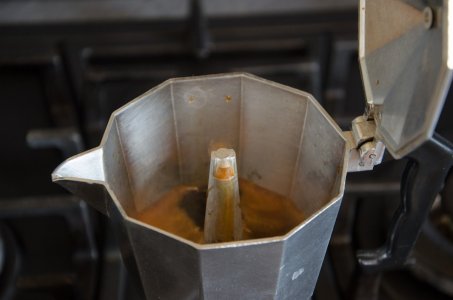Want your coffee to taste even better? Here’s how
For most of us, coffee isn’t just a drink—it’s a lifeline.
‘Coffee is life,’ some coffee lovers even quote, referring to how indispensable coffee is to their daily routine.
But what if that rich, aromatic brew doesn't taste quite as delightful as we recall? Have you ever wondered why your coffee sometimes tastes bitter or less pleasant, making your sips less enjoyable?
Moka pots provide an espresso-like coffee without the high cost, making them a favourite for many globally. But with regular use, the flavour can change.
This change comes from accumulated oils, remaining grounds, and limescale from the water, which can affect the pot's subsequent brews.
Like other coffee devices, moka pots need cleaning after each use.
These pots, made from stainless steel or aluminium, should not be cleaned with abrasive detergents and dishwashers.
For a consistently good brew, it’s important to remove grounds after brewing and perform a deeper clean regularly.
If used often, a thorough clean weekly and limescale removal every six months (depending on water hardness) is recommended.
A moka pot consists of three main sections.
There’s the bottom part where the brewing happens, a middle filter that separates the grounds from the brewed coffee, and the top section where your finished coffee collects.
For regular cleaning after each use, first empty out the old coffee grounds.
Then, give every part a good rinse with hot water, paying special attention to the spout and the area near the safety valve.
Once rinsed, dry all parts with a towel to prevent any water spots or residue.
For deep cleaning, use distilled vinegar.
Keeping an eye on limescale in your moka pot is also crucial for maintaining its performance and the quality of the brew.
In certain cases, limescale can build up over time, potentially altering the taste of your coffee or even clogging the valve and filter holes, despite regular cleaning. That’s why descaling is so important.
To descale the pot, start by adding two tablespoons of distilled vinegar to the bottom chamber of the pot.
Next, fill the chamber with water up to the safety valve. Then, reassemble the pot and let it sit for a few hours.
Afterwards, run the pot through a brewing cycle to cleanse all its parts with the acidic solution. Following this, run a water-only brew cycle to remove any lingering vinegar and limescale.
Finally, once the pot has cooled, dry the interior thoroughly with a towel or paper towel to prevent limescale buildup, ensuring a better-tasting coffee.
How to clean and care for your moka pot (Tutorial). Video source: MokaBees

Members, how regularly do you give your moka pots a good cleaning? Share your routines in the comments below!
‘Coffee is life,’ some coffee lovers even quote, referring to how indispensable coffee is to their daily routine.
But what if that rich, aromatic brew doesn't taste quite as delightful as we recall? Have you ever wondered why your coffee sometimes tastes bitter or less pleasant, making your sips less enjoyable?
Moka pots provide an espresso-like coffee without the high cost, making them a favourite for many globally. But with regular use, the flavour can change.
This change comes from accumulated oils, remaining grounds, and limescale from the water, which can affect the pot's subsequent brews.
Like other coffee devices, moka pots need cleaning after each use.
These pots, made from stainless steel or aluminium, should not be cleaned with abrasive detergents and dishwashers.
For a consistently good brew, it’s important to remove grounds after brewing and perform a deeper clean regularly.
If used often, a thorough clean weekly and limescale removal every six months (depending on water hardness) is recommended.
A moka pot consists of three main sections.
There’s the bottom part where the brewing happens, a middle filter that separates the grounds from the brewed coffee, and the top section where your finished coffee collects.
For regular cleaning after each use, first empty out the old coffee grounds.
Then, give every part a good rinse with hot water, paying special attention to the spout and the area near the safety valve.
Once rinsed, dry all parts with a towel to prevent any water spots or residue.
For deep cleaning, use distilled vinegar.
Keeping an eye on limescale in your moka pot is also crucial for maintaining its performance and the quality of the brew.
In certain cases, limescale can build up over time, potentially altering the taste of your coffee or even clogging the valve and filter holes, despite regular cleaning. That’s why descaling is so important.
To descale the pot, start by adding two tablespoons of distilled vinegar to the bottom chamber of the pot.
Next, fill the chamber with water up to the safety valve. Then, reassemble the pot and let it sit for a few hours.
Afterwards, run the pot through a brewing cycle to cleanse all its parts with the acidic solution. Following this, run a water-only brew cycle to remove any lingering vinegar and limescale.
Finally, once the pot has cooled, dry the interior thoroughly with a towel or paper towel to prevent limescale buildup, ensuring a better-tasting coffee.
How to clean and care for your moka pot (Tutorial). Video source: MokaBees
Key Takeaways
- Moka pots can produce off-flavours in coffee due to built-up oils, leftover grounds, and limescale from water.
- The pots should be washed after every use, avoiding abrasive detergents and dishwashers, and given a deeper clean once a week if used regularly.
- There are three chambers to a moka pot: the brewing chamber, the filter plate, and the upper chamber. All should be rinsed with hot water after use, and the pot can be descaled with distilled vinegar.
- Not cleaning a coffee maker regularly can lead to bad-tasting coffee - following this guide to clean and maintain your moka pot can result in a better-tasting coffee.








